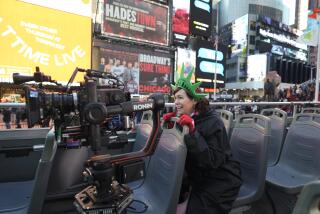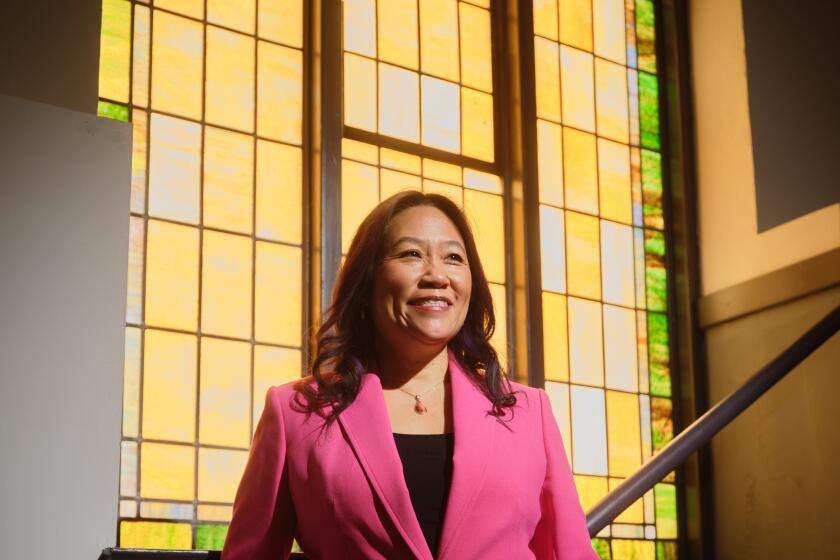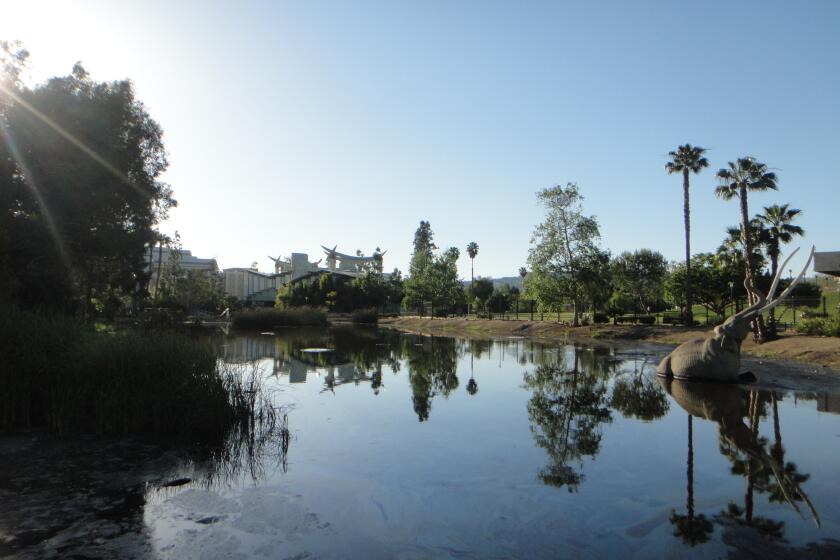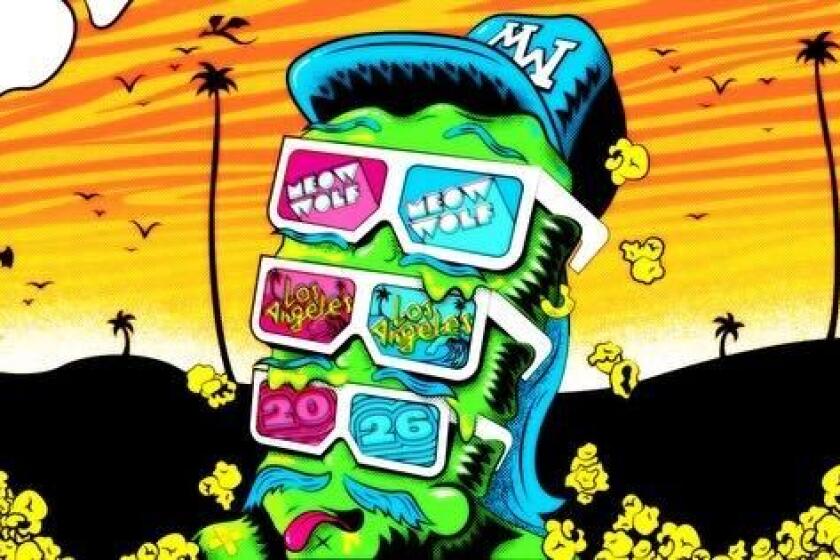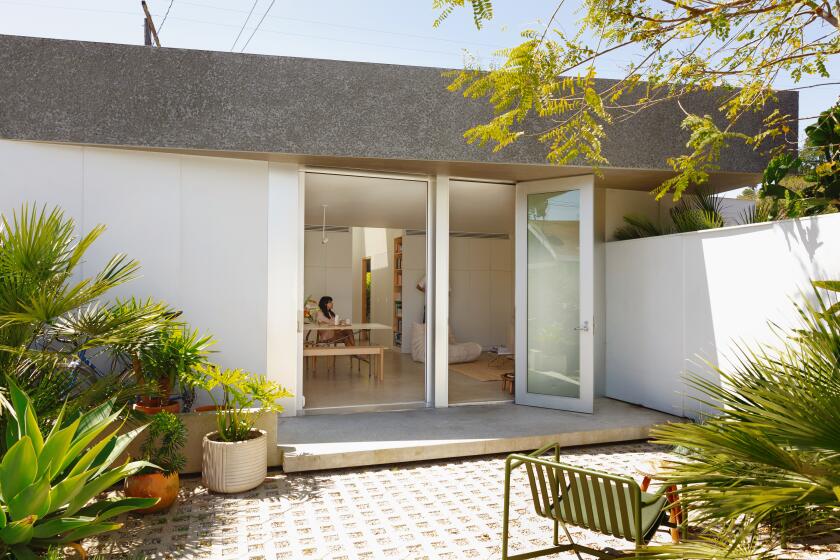Children’s Museum Drafts Big Plans for Its Little Patrons
Adults are building a new $43-million enterprise in Los Angeles, but it will be left up to the imagination of children to run the place.
After five years of planning, fundraising and a difficult search for a site, construction began last week in Lake View Terrace on the new Children’s Museum of Los Angeles, a venue that officials hope will draw more than 350,000 visitors a year and become a key cultural asset for the community and the San Fernando Valley.
“It’s about empowering and educating children,” said Mark Dierking, the museum’s executive director. “The concept is that the museum really doesn’t function without kids.”
Set in the foothill terrain of Lake View Terrace, the museum will revolve around an imaginary ecosystem, intended to show children that everything around them is interdependent -- land, vegetation and climate. It’s up to humans like them to keep the world running smoothly.
The 60,000-square-foot museum, slated to open in mid-2007, will be packed with hands-on displays in which youngsters can learn while they play. They will feed make-believe creatures phosphorus and nitrogen, learn about air currents by donning wings and imitating birds or planes, create puppets and scripts for performances, and learn to cook healthful meals, among other activities.
A key feature will be a transport system called the Big Fun Cool Thing, which will operate much like a giant dry cleaner’s rack. The contraption will ferry children’s artwork, inventions and small construction projects throughout the museum for all to see. The machine will also function as a giant energy exchange system, funneling water, air and sun-generated power to many exhibits.
The ecosystem will have three stand-alone whimsical creatures with which children can interact. Tree will represent the plant kingdom; Dogbear and Puppycub will stand for the animal kingdom. The creatures won’t thrive without human attention. Children will use colored balls to find the right combination of nutrients to feed the tree so that its lighted leaves turn green or its fruit ripens.
“It puts kids in charge and creatively in control,” Dierking said.
In an area called the kitchen, children will learn about cooking customs and healthy eating habits. They will produce food themselves, including simulated fare for Puppycub.
One exhibit will allow children to experiment with water flow by sliding a series of gates to control a cascading stream. In another workshop, youngsters will learn to build small fort-like structures they can play in.
“We really are looking for the next generation of children’s museums,” City Council President Alex Padilla said last week. “My expectation is that it will be the premier children’s museum in the country.”
Padilla, who grew up near what is now the Hansen Dam Recreation Area, where the museum will be, and now represents the area, said the facility will help revitalize a part of Los Angeles where residents have long complained of blighted conditions and a lack of cultural opportunities.
“When I was a kid, we had to make long bus or car trips downtown to see the museums,” he said. “And then if we wanted to go back the next weekend, we couldn’t easily get there. That really hasn’t changed.... Cultural offerings need to be dispersed throughout the city, not just concentrated downtown.”
It was only after decades of effort on the part of Valley residents and lawmakers that the silt-choked Hansen Lake and surrounding 1,400 acres of wilderness were transformed into a handsome park featuring fishing, trails and picnic facilities. The city is leasing an acre of its parkland to the museum for $1 a year.
The new museum, just east of Osborne Street and Foothill Boulevard, will replace the Civic Center Children’s Museum, which closed five years ago because it had no room for expansion, parking was a problem and its lease was expiring.
The board of the nonprofit museum initially considered new quarters close to the old 17,000-square-foot location on Main Street but dropped the idea because it was too expensive. Griffith Park came under serious consideration, only to be shot down by neighborhood groups, which didn’t want more congestion in an already busy area.
After Padilla was elected in 1999, he pushed to bring the museum to Hansen Dam Park. The site offered ample parking, and the tranquil setting was viewed as a major draw. Also, it would boost the east San Fernando Valley’s civic identity, supporters hoped. The City Council approved turning over $9.5 million in city park bond funds as seed money for the museum.
To date, backers have raised $27 million from public and private sources for the project.
“We still need $16 million,” Dierking said. “The building is fully funded. We’re now raising money for exhibits and operations.” After Tuesday’s groundbreaking ceremony, a fundraiser in Beverly Hills brought $350,000 in pledges.
The Los Angeles Children’s Museum will join about 250 youth museums around the nation, with 70 others in the planning or construction stage. Museum advocates say it is vital for children to have a discovery and exploration space to call their own.
“At a children’s museum, they can find out that playing is a way to learn,” said Janet Rice Elman, executive director of the Assn. of Children’s Museums in Washington, D.C.
Los Angeles architect Sarah Graham infused the building design with “green” elements that take advantage of the site’s natural surroundings.
The elongated wedge-shaped two-story structure will nestle against a slope, integrating it with the terrain instead of towering above it. To help cool the building, the structure will have roof-mounted misters that visitors can stroll through.
Graham added playful touches as well. Part of the building exterior will be coated with blackboard paint so that children can draw on it. And solar panels for supplying electricity will be arranged against the building like spots on a cow.
“We did that so it would be noticed and to encourage children to ask questions about how energy is generated,” said Graham, whose design projects have included Midfield Terminal at Zurich International Airport in Switzerland and an aerial tram being built in Portland, Ore.
Inside, where many little hands and feet will be a force to contend with, enameled steel, tough plastics and other durable materials have been included in the design.
“The phrase we use,” Dierking said, chuckling, “is that it has to be combat ready.”
Edwin Schlossberg, whose New York-based firm is designing the exhibits, said he aims to take the term “interactive museum” to a new level in Los Angeles by avoiding the traditional pushbuttons and video screens with signs saying “Learn more.”
The term “interactive” is trendy but often misunderstood, said Schlossberg, who has devised exhibits for dozens of cultural institutions, including the Immigration History Center on Ellis Island.
“The minute you introduce video, you aren’t interacting with it,” he said. “You’re getting a message someone wants to convey.”
He hopes that children who have spent a day at the museum will have had fun but will also be newly excited about the world around them.
“We’ve worked really hard not just to show the interdependence of our lives, but that it takes collaboration to be human beings,” he said. “I would love it if they learned that it’s both what you know and what your friends know that makes a difference.”
More to Read
The biggest entertainment stories
Get our big stories about Hollywood, film, television, music, arts, culture and more right in your inbox as soon as they publish.
You may occasionally receive promotional content from the Los Angeles Times.
